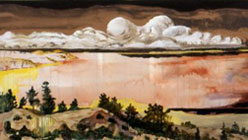One artist I spoke with was initially very excited to have his work included in the White Columns Artist Registry. However, he told me that in the few years that have passed since his acceptance, the only result has been an increase in the amount of junk mail he receives. He does still take the time to update his page, but assumes at this point that nothing will come of it. Another artist whose work was accepted for a New American Paintings catalog a couple of years ago told me that it “did not pan out into anything.”
One of the first adopters of Saatchi Online said of the registry, “I don’t think it hurts — but I cannot say it has helped yet. I did receive a query… and they may have found me on Saatchi, but nothing has come of that yet. Otherwise it is such a mixed bag there — most of the artists are not that developed… [but] they do find serious curators for their ‘Showdowns.'” She added, “To be frank, nothing is as good as your own website, and this goes for Blogger, Tumblr and the million other ways you can expose your work.”

Mamma Andersson, Pigeon House, 2010.
Granted, these are the accounts of only three random artists among thousands, so it’s hard to say if theirs is the experience of the majority or not. I’d like to believe that the registries are helpful — readers please note that Saatchi Online was where I found the collages of Irina and Silviu Székely, featured in this column a few weeks ago — but the last part of your question acknowledges the necessity of actually being physically present, at least sometimes, in order to be on a gallerist’s or curator’s radar.
There are no certainties in this game we play. By all means, I think that providing one more place for gallerists and dealers to find your work could prove helpful to your objective of selling. But don’t let the energy you’re putting into an online presence take away from the time you spend connecting to people in real life. The glib phrase “it’s who you know” is not quite accurate — you could be on a first name basis with the pope and it won’t make your work any better — but it’s not entirely inaccurate either. If you do pursue and get your work into these registries, see if you can use that as a very deliberate stepping stone to a face-to-face meeting with a gallery you’ve had your eye on.

Mamma Andersson, Filly, 2010.
I’m an artist without an art school background. I’ve made art my whole life but only for me personally, until the last few years, when I began to devote much more of my time to it and to put it out in juried shows and other exhibitions. I’ve had some serious encouragement with a few large sales and two solo shows (one in a high quality art venue, one in a public space) in the four years since I changed course. I remain self-employed in my “day job” which is tangentially related to the art I make in that I carry themes over from one realm to the other. My question is about how to portray myself to galleries as I reach out to them. I want to be honest about my background but I am realistic enough to know that there are some prejudices against those who come later and roundabout to artmaking. I want to emphasize that I am extremely serious about it and hope to make a complete switch if at all possible.
I think you should portray yourself honestly: you have been making art your whole life and have recently produced some bodies of work that have been successful in the marketplace. In terms of gallerists and dealers, why would any other information be germane to the matter at hand? Do I need to know if my dentist has an undergraduate degree in modern dance, or do I want to know if she is experienced, licensed and insured? Capisce? No one (at least no one you’re going to care about) will give a damn about art school if your work is strong and interesting, you present yourself well and have a good statement.
It would be silly to pretend that there are not all sorts of prejudices in the art world. On one hand I would never suggest that anyone lie about their background, and on the other I detest those cloying self-taught/self-made/”pulled myself up by my bootstraps” stories that sometimes pass for artist statements. Your lack of an art degree should be neither a shame nor a source of pride but a simple fact, one among many. To some people it can matter if you have an MFA or not, are old or young; black or white or Hispanic; male or female, etc. But the people who might have a problem with your age, background or apparent lack of pedigree are not the people you want to work with. Why? Because these people will not help you on your way, they will not sell your work, and they will not bolster your confidence when you are down. You will not enjoy their company or their version of what passes for wisdom. Leave these people alone because they will definitely be toxic for your studio practice and quite possibly for your career.
Are you reading some of the art-career books out there? I highly recommend that you peruse the shelf at your local bookstore. Many of these publications will lay out the specifics of how to talk about your work and your evolution as an artist without sounding defensive or smug. The way to emphasize your seriousness about art is to keep a regular studio practice, invest in your materials and development, and present the best work you have at all times. Good luck!





